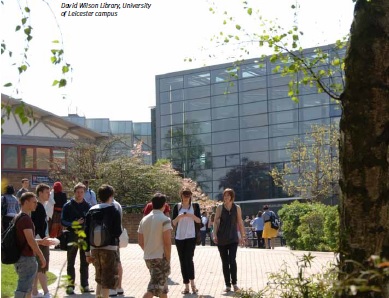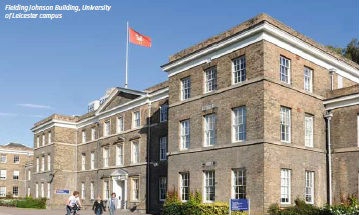Gent’s Part 23 compliant devices get a first at University of Leicester
The University of Leicester’s high quality academic reputation has earned it a position in the top 2% of universities of the world, and a ranking in the top 20 of UK major national league tables. Based a mile south of Leicester city centre, the University’s compact campus contains a wide range of twentieth century architecture, from the oldest building, which dates back to 1837, to its three distinctive towers built in the 1960s.
Like all educational establishments, the welfare and safety of its students is the University of Leicester’s highest priority, whether it is security procedures in the teaching halls or fire protection in the student accommodation. There are 23,000 students attending the University and a significant proportion of these reside in the multiple accommodation blocks based close to the main campus.
One of the University’s accommodation blocks, part of Oadby Student Village, has recently undergone a refurbishment of its fire alarm and detection (FDA) system as the existing system became obsolete. Marston Fire, based in Loughborough in Leicestershire, carried out the install having won the contract when the business was put out to tender.
Oliver Marston, managing director, Marston Fire, oversaw the installation and was involved in the tender process from the initial stages. Marston said: “The original brief was to replace the existing fire alarm system that was obsolete and the only solution that would meet all of the University’s requirements was the Gent system that we put forward. We had to use the existing wiring that was already in place and install a brand new panel and detection devices.”
The solution that was selected for the project was the Vigilon Compact panel together with Gent’s brand new EN54-23 approved S-Quad devices.
Marston continued: “This was the very first installation of Gent’s new S-Quad devices and when the discussions took place about the benefits of the new VADs, the customer was very keen to use them. The University is already familiar with Gent’s products as their FDA systems are installed in a number of buildings across the main campus, so it was an ideal opportunity to try out the new devices.”
The S-Quad devices conform to the European Standard EN54-23, which specifies the criteria for Visual Alarm Devices (VADs). Prior to EN54-23 there was no way to determine the effectiveness of a VAD, so the requirement was introduced primarily to standardise the VADs rating and performance.
T

he VADs usually provide a primary alert for deaf or hard of hearing people, or for areas with high background noise. In the University of Leicester’s student accommodation the flashing strobes were designed to meet BS5839 pt1 and EN54-23, providing 0.4lux above the ambient light levels. This allowed the VAD’s to be used as the primary source of indication for the building’s residents if required.
Marston carried out the installation at the end of April. As the building was occupied, one of the biggest challenges for the project was the very short timeframe for completion.
Marston said: “We installed the system in the morning and it was fully operational the same evening so it took less than a day to complete. The existing product was removed early in the morning and the new Gent solution was up and running later that day.
“The main challenge, apart from the speed of turnaround, was to remove all the existing equipment as it was not compatible. Once we changed over to the new system we used the new loop diagnostic software from Gent. We tested the system alongside the Gent development team which provided an extra measure of assurance and gave us a health check on the existing cabling in line with the manufacturer’s recommendations.”
Dan Ascough, business manager, Gent by Honeywell, said: “The FD&A solution was completed successfully and the University has since praised the speed and professionalism of the installation team. The system is providing the University with the highest possible fire detection and evacuation technology, the higher power strobe output in the new S-Quad VADs will ensure the students are safeguarded in any fire scenario.”
Further upgrade plans to specific areas of the University of Leicester’s FD&A system are set to take place in the summer.
Students get first class protection in luxury accommodation
 Sanctuary Students Grenville Street is by no means your typical type of student accommodation. The private building is a stylish new development located in Liverpool city centre, with every aspect designed to offer the most luxurious standard of student living.
Sanctuary Students Grenville Street is by no means your typical type of student accommodation. The private building is a stylish new development located in Liverpool city centre, with every aspect designed to offer the most luxurious standard of student living.
Situated close to both The University of Liverpool and Liverpool John Moores University, the brand new building is ideally located for studying, shopping and socialising. The modern six storey property offers students a choice of either personal studio apartments, or shared luxury apartments accommodating four, five or six people. All rooms offer en-suite bathrooms and double beds and the vast public areas of the building include spacious common rooms and on-site laundry facilities, as well as the security and plant rooms.
When it comes to the safety of the building’s resident and visitors, having the most reliable and efficient fire detection and alarm (FDA) system to protect both life and property is critical. The FDA installation at the high spec building, included a Gent by Honeywell solution, selected to offer to the most robust protection for the occupants and building. The installation was completed last summer ready for the start of the academic 2014 term.
HE Simm was the main electrical contractor and the FDA system was designed, commissioned and installed by one of Gent’s key systems integrators HESIS.
Allan Wong, HESIS, said: “An L4 category system was selected to cover the congregated areas, including the fire escapes, corridors and common areas. The Gent Vigilon system was installed alongside a range of the company’s S-Quad multi sensor detectors to provide the most sophisticated detection, and also minimise the number of unwanted false alarms at the property.”
The main Vigilon panel was installed in the reception lobby, and the system incorporated a paging system to connect it to the fire alarm.
Allan Wong said: “The flexibility of the Vigilon solution allowed us to connect it to a paging system for the staff on duty in the building. Each of those employees will now be given notification of any alarms via a signal on their paging device. The fire alarm was also interfaced into the AOV (automatic opening vents) system which operates every single vent throughout the property, so the vents will open automatically on detection and the windows on the lift lobbies on all floors will open in the event of a local fire.””
In addition, the Gent solution was also fully interfaced into Grenville Street’s plant rooms and also covers the property’s adjoining car park. Heat detectors with beacons were installed throughout the car park.
Allan Wong said: “The other element of the FDA solution is that in the event of an activation in the car park the system has been configured to trigger in the plant room which then automatically turns the fans on to extract the smoke from the car park.
“Students residing in Liverpool’s Grenville Street property have been given the ultimate protection by the Gent system. The occupants can enjoy the luxury of their surroundings safe in the knowledge that the most robust and reliable solution is at work behind the scenes.”


